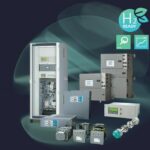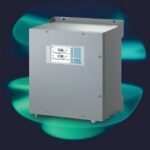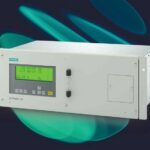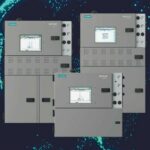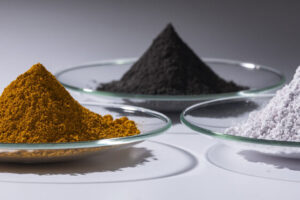Climate-neutral, sustainable, clean: there’s lots to be said for molecular hydrogen as a way out of the climate crisis. But because the gas doesn’t naturally occur in significant quantities, it first has to be generated – and this requires energy. If the energy comes from renewable sources like the sun and wind, the result is a portable, sustainable fuel with a wide range of applications in road, marine and air transport as well as in industry.
One way to produce hydrogen is to use an electrolyser, which is the centerpiece of power-to-gas plants. Electrolysers use electricity to break down water electrolytically into hydrogen and oxygen. Although the electrolysis process separates the two gases, traces of O2 in H2 and of H2 in O2 must be continuously measured to prevent, above all, the creation of explosive oxyhydrogen gas by leakage, for example. Siemens’ flexible Siprocess GA700 gas analyser elegantly performs both measurements in a single device equipped with the Calomat 7 module, which measures hydrogen using thermal conductivity, and with the Oxymat 7 module, which measures oxygen paramagnetically.
Using hydrogen in gas-fired power plants
Hydrogen is already a key raw material for the chemical industry – for the production of ammonia, for example. However, its use as an energy source is still in its infancy – a situation that policymakers now intend to change fundamentally. Under the EU Taxonomy Regulation adopted by the European Commission, gas-fired power plants are classified as climate-friendly, but must be hydrogen-compatible and, by 2036, capable of running on H2 alone. The German government has increased the pressure by insisting that some new gas-fired power plants must be “hydrogen-ready” as early as 2028. The course has therefore been set.
Because converting gas-fired power plants into purely hydrogen-fired plants will require substantial investment and there still won’t be enough “green hydrogen” available, plans call for adding H2 to natural gas. Here, too, the Calomat 7 module in a GA700 gas analyser can continuously measure H2 in order to accurately regulate the turbine and optimise the process. In practice, projects usually start with a low percentage of H2 by volume – for example, 15 %. If the result is positive, this proportion is then gradually increased since the higher the hydrogen content, the less carbon emission for each megawatt-hour generated. However, the exhaust gas emitted by the plant must also be monitored by instruments at all times. The robust Ultramat 23 gas analyser can continuously measure up to four gases simultaneously, including CO, CO2, SO2 and various nitrogen oxides. This analyser is part of the Set CEM CERT, a system that contains even more modules for processing gas samples – for example, a gas cooler to extract moisture from samples that could impede the measurement process, a pump and a NOX converter. The Set CEM CERT also monitors compliance with legal limits.
In the future, high-sensitivity laser spectroscopy procedures for measuring gas emissions will grow in importance due, among other things, to the steady lowering of legal limits. In-situ gas analysers based on this technology measure faster than extractive instruments, facilitating immediate adjustments for process optimisation.
Special measurement requirements for fuel cells
One technology that will benefit from the energy transition is the “cold combustion” of hydrogen in fuel cells. This process is already used in vehicle drives and industrial applications. However, the electrochemical process in fuel cells is sensitive to catalyst poisons such as carbon monoxide (CO), in particular. CO may originate in ambient air or result from the gas humidity caused by carbon corrosion on the electrode plates. Concentrations of just a few ppm can be enough to contaminate catalysts and cause significant performance losses. Reliable CO monitoring in complex gas mixtures is performed by a GA700 gas analyser equipped with an Ultramat 7 module. Thanks to its modular structure, the GA700 can simultaneously measure other gases that can also damage the catalyst – for example, CO2 and sulfur and nitrogen oxides.
Precise measurement is the top priority for all gas analysers, which is why they have to be regularly validated and, when necessary, calibrated. Special software from Siemens like the Analyzer System Manager centrally calculates and analyzes incipient drift for all devices, including those from other vendors. Due to its ability to predictively analyze a wide range of device data, the Analyzer System Manager can identify an impending need for maintenance, even before an inadmissible deviation occurs, and automatically perform a fault analysis, thus maximizing device availability. Maintenance can also be optimized by accessing devices remotely and planning necessary service activities entirely digitally and automating them in part – for example, the reporting of key performance indicators (KPIs).
E-fuels and biofuels
Because hydrogen’s transport and safety pose significant challenges and because the universal replacement of internal combustion engines won’t be possible in the foreseeable future, work is proceeding on new fuels that most closely approximate the chemical composition and physical properties of conventional fuels. These “E-fuels” are hydrocarbons produced from water and CO2 using electricity. If this electricity comes from renewable sources and the CO2 from the atmosphere, engines using these fuels can be climate-neutral. But the fact remains that other sustainable fuels offer a more favorable energy balance.
A variety of biofuels have already been thoroughly tested. These fuels are made from organic material, which means they’re better from an energy perspective and don’t require carbon capture. E10 fuel, which has a maximum bioethanol content of ten percent, is already widely known. But the raw materials needed to produce bioethanol compete with food requirements. That’s why Siemens has been working with partner entities on a number of projects to produce non-competing “advanced biofuels” sourced from hydrated vegetable oil or solid biomass. The BioTfueL Project has successfully converted low-cost residues (mainly agricultural and forestry waste) into biodiesel using a thermochemical process. This process involves the continuous use of gas analysers equipped with Calomat and Ultramat modules. Maxum process gas chromatographs from Siemens are also used because many gases must be monitored during the catalytic synthesis and product purification processes. The Maxum Edition II – which utilises a wide selection of ovens, detectors, separation columns and the ability to conduct measurements with three detectors simultaneously – offers the ideal prerequisites for supplementing the monitoring functions of Siemens’ continuous gas analysers.
Siemens AG, Nürnberg





